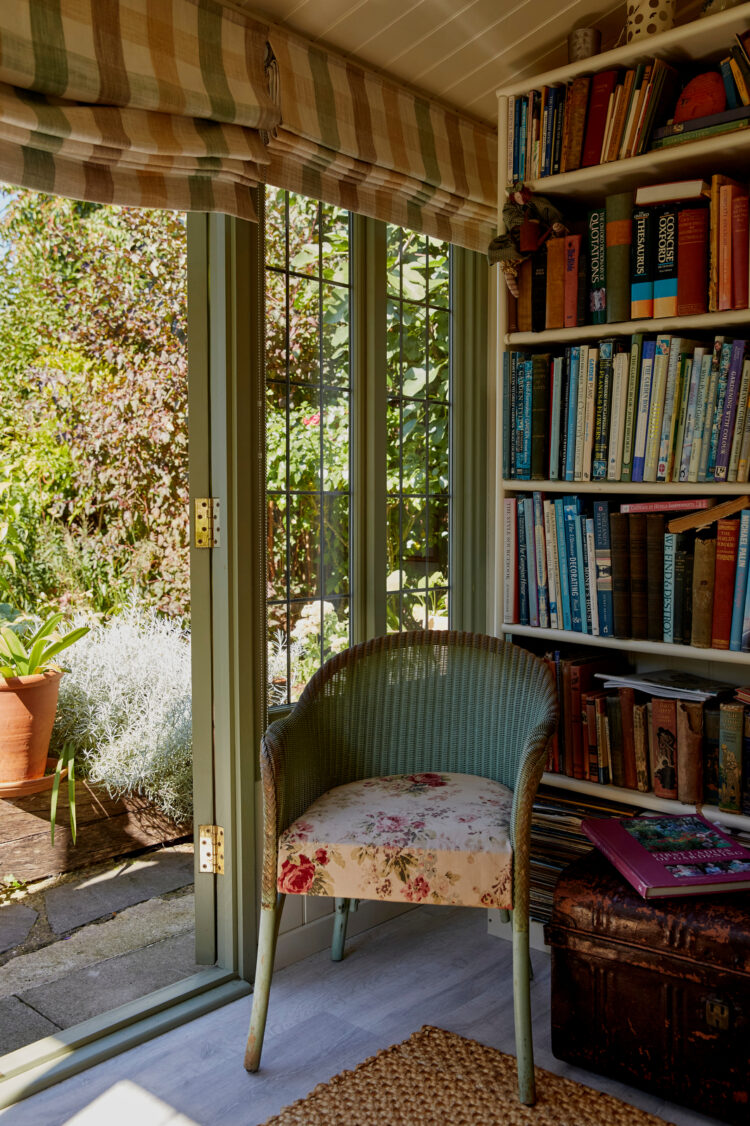A somewhat cryptic headline for this week’s househunter as we will be decoding the interior design tactics used in this house which was lived in by Alan Turing, Harry Hinsley and John Tiltman during the time they worked as codebreakers. It’s a six minute drive from Bletchley and is on the market with Inigo for £465,000 including the blue plaque.
It’s a sweet little cottage set on a quiet road (fitting for codebreakers I guess!) and has two bedrooms and a bathroom upstairs and a sitting room, dining room and kitchen downstairs. There’s always a gorgeous little garden room with full electrics so that’s clearly the space to work from home. It’s painted in Farrow and Ball Breakfast Room Green and has clearly been decorated to chime with the main house as we shall see. The green works perfectly for a garden room but is also brought into the house. The cream wooden cladding and striped blinds elevate this space into so much more.
Moving inside you can see how this room is a sort of inside version of the garden room. This can be a really fun way to play with decor while keeping a cohesive thread. You might not have a garden room like this (in our dreams) but a conservatory or sun room on the back of the house or even if you have a sitting area in the kitchen then you can use this technique.
So you might have a more formal sitting room but use the same colours in another seating area, or change up the materials from velvet to cotton. Here the blinds are the same stripe to link the space and the walls are the same but the chairs, while the same colour are different styles. It’s about playing with texture and style to create a more relaxed or intimate space while making it clear that the two rooms are part of the same whole.

The other decorating trick used in this house is the simple colour palette. Yer classic English country cottage like this – with thatched roof to add to the chocolate box appeal, has low ceilings, small windows, cosy (shall we we say) rooms and not many of them. Now you can, of course, take the full English country decorating style and fill it with maximalist prints and colours but the owners of this have been a little more subtle. They’ve left the flowers to the garden and, instead, created a simple backdrop that talks to the environment without trying to compete.

Of course if your house is in a city on a busy road with a view of more houses you might want to take a different approach. But you can see from the image above how the garden room sits so perfectly in, well, the garden.

Now let’s look at the inside. We’ve already talked about the pale cream walls, the green accents and you can see here the antique and vintage furniture. But the other thing to note is that this house is actually quite full. This is not a house of minimalists but because the decor and furnishings are quite simple, it provides a backdrop for the objects rather than fighting with them.

Everyone will have different views on what turns an edited curation to a large collection and from there to clutter but if your space is restricted – and whose isn’t? – then if you don’t want to get rid of the stuff you need to give it room to breathe and that means paring back the decor around it so that everything – and everyone – has room to breathe.
It’s about creating a calmer space and while, again, I know that everyone reacts differently to different things, it’s true (universally acknowledged) that filling a room with colour and pattern and pictures and photos and cushions and curtains and ornaments is going to give the brain a workout trying to decide where the eye should land. And once it’s landed is it going to rush off and land on something else before it’s had time to digest the first thing?

So by all means have lots of things – I love stuff and I have lots of it – but give it space to breathe. That way you can see it and it will be appreciated. And if, on the other hand, your heart sings when it sees bright colours and lots of patterns and fabrics all mixed up together then perhaps you want to keep the ornaments and pictures to more of a minimum.

It’s back to that age-old quote, first made in the 1960s by Betty Friedan but since quoted by every woman since: “You can have it all just not at the same time.” Die-hard maximalists might disagree with me (perhaps we should discuss this on the podcast) but I think many of them live in large houses with big rooms and that does make it easier.
What do you think?


